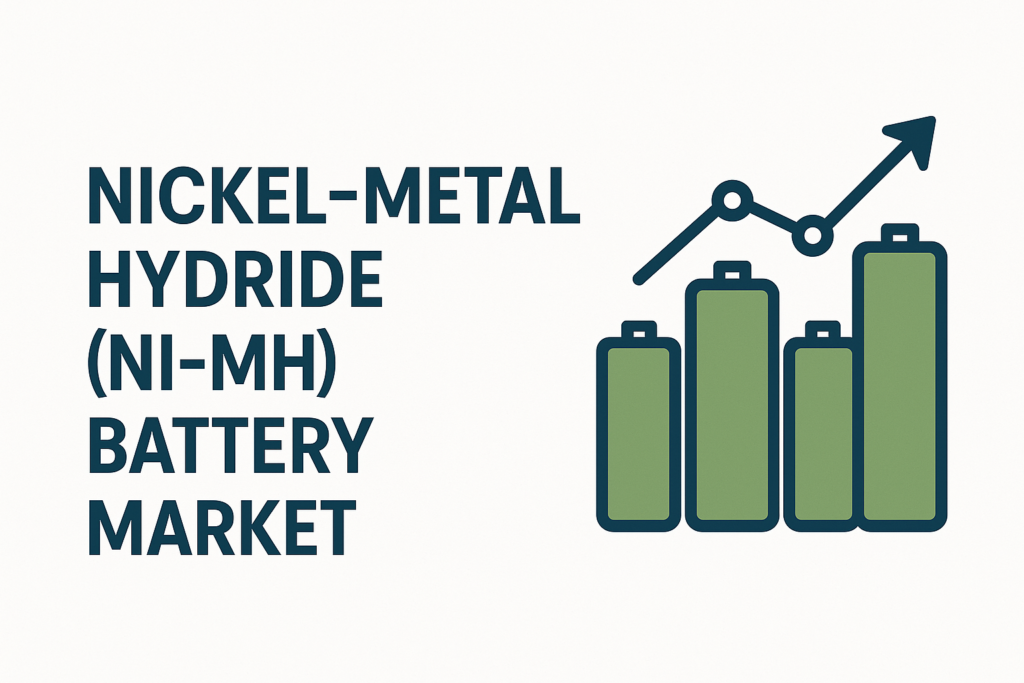Nickel-Metal Hydride (Ni-MH) Battery Market Overview
Current Market Size & Value (2024 estimate): The global Ni-MH battery market is relatively mature and niche compared with fast-growing lithium-ion chemistries, yet it retains a meaningful footprint in specific use cases that reward robustness, tolerance to abuse, and recyclability pathways for nickel content. On a sell-in basis (cell + pack value), the 2024 global market is broadly estimated in the USD 1.2–1.6 billion range. Volumetrically, shipments have trended sideways to slightly down in legacy consumer formats but more resilient in industrial and certain transportation aftermarket channels. Regional demand remains strongest in Asia (cell production), with notable consumption pockets in North America, Europe, and parts of Asia-Pacific for industrial and transportation applications.
Growth Outlook (5–10 Years): Aggregate revenue growth is expected to be flat to low-single-digit CAGR (-1% to +2%) through 2030 under a base case, masking divergent segment trajectories: consumer shrinkage; industrial and specialty growth; automotive hybrid replacement stable but slowly transitioning; emerging stationary niches modestly expanding. In an upside scenario—if regulatory frameworks further favor proven chemistries with established recycling streams and if supply volatility in other metals raises relative Ni-MH attractiveness—market value could approach the upper end of the band with ~3% CAGR. A downside case, driven by rapid cost compression in lithium-ion for cylindrical consumer replacements and broader chem diversification in hybrid drivetrains, could push a -3% CAGR.
Why Ni-MH Still Matters:
-
Thermal and Abuse Tolerance: Ni-MH cells are less sensitive to overcharge and thermal runaway than many high-energy lithium systems, simplifying pack design in ruggedized and mission-critical equipment.
-
Cycle Durability Under High-Variability Loads: The chemistry tolerates repeated shallow cycling and intermittent charge acceptance, useful in start-stop systems, industrial instruments, and emergency gear.
-
Nickel Value & Recycling Infrastructure: Mature recycling channels that recover nickel help offset lifecycle cost and align with circular-economy policies.
-
Regulatory, Qualification, and Design Legacy: Many regulated devices (medical, instrumentation, safety systems) were qualified years ago on Ni-MH platforms; requalification to lithium may be costly or slow, extending the installed base.
-
Self-Discharge Improvements: Advanced low-self-discharge Ni-MH formulations have lengthened shelf life for consumer and professional rechargeables, sustaining a loyal user base.
Key Industry Advancements & Technology Trends:
-
Low-Self-Discharge (LSD) Electrolyte/Separator Systems: Reducing calendar self-discharge below older chemistries has broadened applicability in intermittently used devices.
-
High-Temperature Electrolyte Optimization: Enhancements target performance stability in environments that routinely exceed 60°C, supporting industrial and under-hood uses.
-
Higher Power Density Cathode Alloys: Incremental gains improve charge acceptance for regenerative pulses (important in mild hybrid and energy recovery systems).
-
Form Factor Customization: Prismatic and pack-integrated designs for OEM industrial devices allow better volumetric efficiency versus older cylindrical standard cells.
-
Recycling Process Efficiency: Incremental improvements in nickel reclamation yields and hydrometallurgical process economics support closed-loop sourcing claims—an increasingly valued procurement criterion.
Market Forces Influencing the Next Decade:
-
Chemistry Substitution Pressure from Lithium-Ion: Price erosion in lithium chemistries will continue to convert some consumer and light industrial loads; however, qualification lag and safety headroom will slow total displacement.
-
Policy & Sustainability Mandates: Extended producer responsibility (EPR) laws, recycling targets, and carbon disclosure frameworks could support chemistries with established reclaim streams, providing relative tailwinds to Ni-MH in regulated sectors.
-
Raw Material Pricing Cycles: Nickel price volatility can either compress margins or spur recycling efficiencies; relative cobalt pricing swings in other chemistries occasionally make Ni-MH more attractive for certain buyers.
-
Aftermarket & Installed Base Replacement: Large historical shipments into transportation hybrids and professional devices continue to generate multi-year service and replacement demand, cushioning headline declines.
Nickel-Metal Hydride (Ni-MH) Battery Market Segmentation
Below are four major segmentation lenses with representative subsegments. Each segment discussion is ~200 words.
1. Transportation & Mobility Power Modules
Subsegments: (a) Hybrid & Mild-Hybrid Vehicle Packs (legacy platforms, service replacements); (b) Start-Stop Auxiliary Power Units; (c) Low-Speed / Niche Mobility (industrial carts, material-handling vehicles, specialty off-road equipment).
Transportation historically anchored Ni-MH volume because earlier-generation hybrid drivetrains adopted the chemistry for its thermal stability and pulse-power tolerance. While most new hybrid designs have migrated toward lithium variants for energy density gains, the installed base of vehicles that originally shipped with Ni-MH continues to require pack replacements over service lifetimes, creating a stable aftermarket revenue stream even as original-equipment demand fades. In start-stop applications, Ni-MH modules compete with advanced lead and lithium solutions; selection depends on cost, ambient temperature swings, and charge-acceptance specs defined by engine control strategies. Low-speed electric mobility fleets in industrial settings value Ni-MH for ruggedness, tolerance to opportunity charging, and lower oversight demands where high-skilled battery management is limited. This segment’s long-tail service and refurbishment activity helps smooth variability in primary demand, though value trends depend heavily on raw nickel pricing and pack rebuild economics. Over the forecast horizon, segment revenue is expected to erode slowly in OEM channels but remain material in aftermarket support, yielding a modest decline in volume but relatively flatter revenue as pack value per unit rises with materials and compliance costs.

